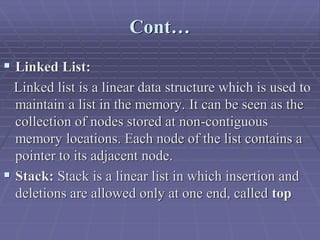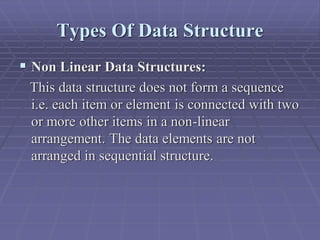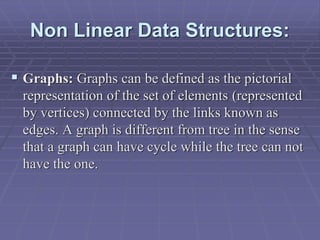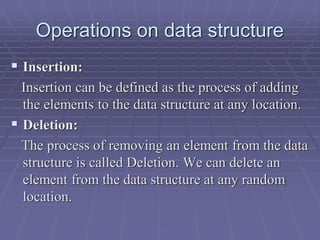Chapter 1 Introduction to Data Structures and Algorithms.pdf
- 1. Data Structures & Algorithms Chapter One : Introduction to Data Structures Need of Data Structures Advantages of Data Structures Data Structure Classification Operations on data structure
- 2. Introduction Data Structure can be defined as the group of data elements which provides an efficient way of storing and organizing data in the computer so that it can be used efficiently. Data Structures are widely used in almost every aspect of Computer Science i.e. Operating System, Compiler Design, Artificial intelligence, Graphics and many more.
- 3. Introduction Data Structures are the main part of many computer science algorithms as they enable the programmers to handle the data in an efficient way. It plays a vital role in enhancing the performance of a software or a program as the main function of the software is to store and retrieve the user's data as fast as possible
- 4. Algorithm An algorithm is a procedure having well defined steps for solving a particular problem. Algorithm is finite set of logic or instructions, written in order for accomplish the certain predefined task. It is not the complete program or code, it is just a solution (logic) of a problem.
- 5. Categories Of Algorithm The major categories of algorithms are given below: Sort: Algorithm developed for sorting the items in certain order. Search: Algorithm developed for searching the items inside a data structure. Delete: Algorithm developed for deleting the existing element from the data structure. Insert: Algorithm developed for inserting an item inside a data structure. Update: Algorithm developed for updating the existing element inside a data structure.
- 6. The performance of algorithm is measured on the basis of following properties: Time complexity: It is a way of representing the amount of time needed by a program to run to the completion. Space complexity: It is the amount of memory space required by an algorithm, during a course of its execution. Space complexity is required in situations when limited memory is available and for the multi user system.
- 7. Example: Design an algorithm to multiply the two numbers x and y and display the result in z. Step 1 START Step 2 declare three integers x, y & z Step 3 define values of x & y Step 4 multiply values of x & y Step 5 store the output of step 4 in z Step 6 print z Step 7 STOP
- 8. Alternatively the algorithm can be written as ? Step 1 START MULTIPLY Step 2 get values of x & y Step 3 z← x * y Step 4 display z Step 5 STOP
- 9. Exercise Design an algorithm for a booking cap app?
- 10. Characteristics of an Algorithm An algorithm must follow the mentioned below characteristics: Input: An algorithm must have 0 or well defined inputs. Output: An algorithm must have 1 or well defined outputs, and should match with the desired output. Feasibility: An algorithm must be terminated after the finite number of steps. Independent: An algorithm must have step-by-step directions which is independent of any programming code. Unambiguous: An algorithm must be unambiguous and clear. Each of their steps and input/outputs must be clear and lead to only one meaning.
- 11. Asymptotic Analysis In mathematical analysis, asymptotic analysis of algorithm is a method of defining the mathematical foundation of its run-time performance. Using the asymptotic analysis, we can easily conclude about the average case, best case and worst case scenario of an algorithm.
- 12. Usually the time required by an algorithm comes under three types: Worst case: It defines the input for which the algorithm takes the huge time. Average case: It takes average time for the program execution. Best case: It defines the input for which the algorithm takes the lowest time.
- 13. Asymptotic Notations The commonly used asymptotic notations used for calculating the running time complexity of an algorithm is given below: Big oh Notation (Ο) (Worst case ) Omega Notation (Ω) (Best case ) Theta Notation (θ) (Average case )
- 14. Need of Data Structures As applications are getting complexed and amount of data is increasing day by day, there may arise the following problems: Processor speed: To handle very large amount of data, high speed processing is required, but as the data is growing day by day to the billions of files per entity, processor may fail to deal with that much amount of data.
- 15. Need of Data Structures Data Search: Consider an inventory size of 106 items in a store, If our application needs to search for a particular item, it needs to traverse 106 items every time, results in slowing down the search process. Multiple requests: If thousands of users are searching the data simultaneously on a web server, then there are the chances that a very large server can be failed during that process
- 16. Need of Data Structures in order to solve the above problems, data structures are used. Data is organized to form a data structure in such a way that all items are not required to be searched and required data can be searched instantly.
- 17. Advantages of Data Structures Efficiency: Efficiency of a program depends upon the choice of data structures. For example: suppose, we have some data and we need to perform the search for a particular record. In that case, if we organize our data in an array, we will have to search sequentially element by element. hence, using array may not be very efficient here. There are better data structures which can make the search process efficient like binary search tree or hash tables.
- 18. Advantages of Data Structures Reusability: Data structures are reusable, i.e. once we have implemented a particular data structure, we can use it at any other place. Abstraction: Data structure is specified by the ADT which provides a level of abstraction. The client program uses the data structure through interface only, without getting into the implementation details.
- 20. Types Of Data Structure Linear Data Structures: A data structure is called linear if all of its elements are arranged in the linear order. In linear data structures, the elements are stored in non-hierarchical way. Types of Linear Data Structures are given below: Arrays: An array is a collection of similar type of data items and each data item is called an element of the array. The data type of the element may be any valid data type like char, int, float or double.
- 21. Cont… The elements of array share the same variable name but each one carries a different index number known as subscript. The array can be one dimensional, two dimensional or multidimensional. The individual elements of the array age are: age[0], age[1], age[2], age[3],......... age[98], age[99].
- 22. Cont… Linked List: Linked list is a linear data structure which is used to maintain a list in the memory. It can be seen as the collection of nodes stored at non-contiguous memory locations. Each node of the list contains a pointer to its adjacent node. Stack: Stack is a linear list in which insertion and deletions are allowed only at one end, called top
- 23. Cont… Queue: Queue is a linear list in which elements can be inserted only at one end called rear and deleted only at the other end called front.
- 24. Types Of Data Structure Non Linear Data Structures: This data structure does not form a sequence i.e. each item or element is connected with two or more other items in a non-linear arrangement. The data elements are not arranged in sequential structure.
- 25. Non Linear Data Structures: Trees: Trees are multilevel data structures with a hierarchical relationship among its elements known as nodes. The bottom most nodes in the hierarchy are called leaf node while the top most node is called root node. Each node contains pointers to point adjacent nodes. Tree data structure is based on the parent-child relationship among the nodes. Each node in the tree can have more than one children except the leaf nodes whereas each node can have at most one parent except the root node.
- 26. Non Linear Data Structures: Graphs: Graphs can be defined as the pictorial representation of the set of elements (represented by vertices) connected by the links known as edges. A graph is different from tree in the sense that a graph can have cycle while the tree can not have the one.
- 27. Operations on data structure Insertion: Insertion can be defined as the process of adding the elements to the data structure at any location. Deletion: The process of removing an element from the data structure is called Deletion. We can delete an element from the data structure at any random location.
- 28. Operations on data structure Searching: The process of finding the location of an element within the data structure is called Searching. There are two algorithms to perform searching, Linear Search and Binary Search. We will discuss each one of them later .
- 29. Operations on data structure Sorting: The process of arranging the data structure in a specific order is known as Sorting. There are many algorithms that can be used to perform sorting, for example, insertion sort, selection sort, bubble sort, etc. Merging: When two lists List A and List B of size M and N respectively, of similar type of elements, clubbed or joined to produce the third list, List C of size (M+N), then this process is called merging
- 30. Assignment1 1 Define data structures. Give some examples. 2 Discuss the applications of data structures. 3 Write a short note on different operations that can be performed on data structures. 4 Compare a linked list with and array. 5 Discuss the best case, worst case, average case, time complexity of an algorithm.
- 31. END
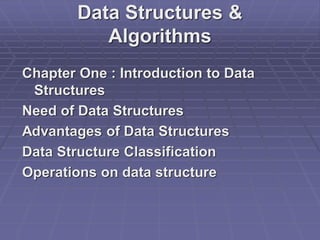
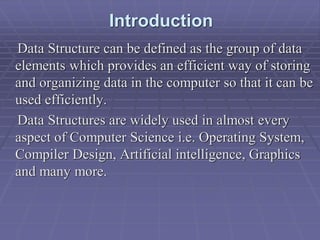
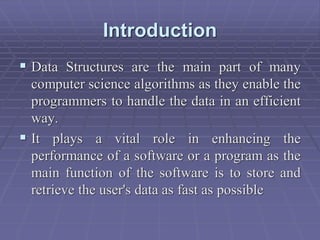
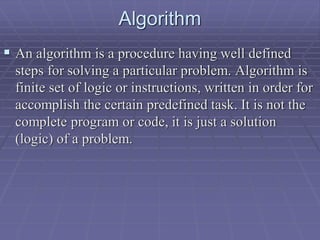
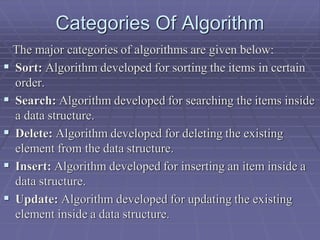
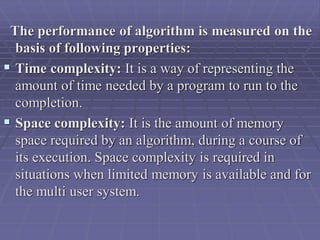
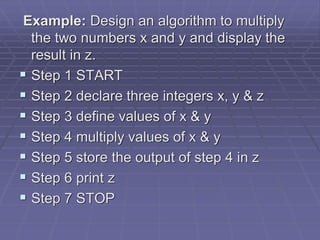
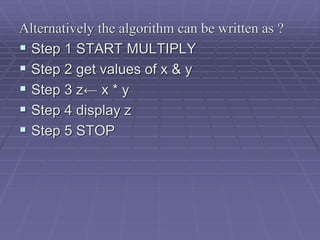

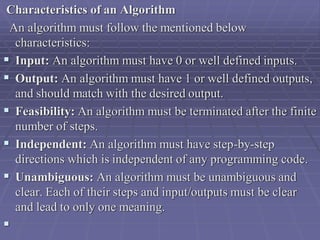
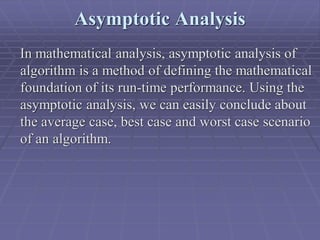
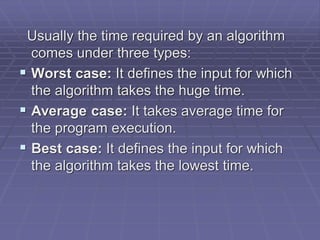
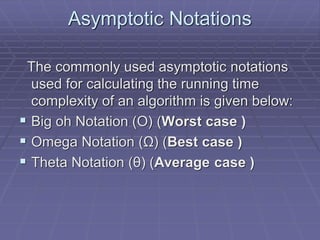

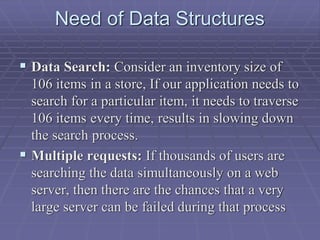
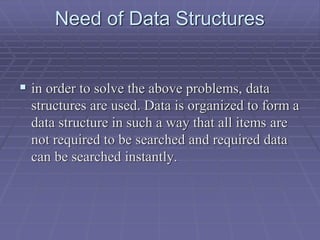
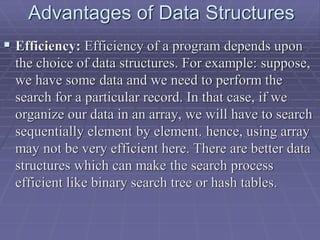
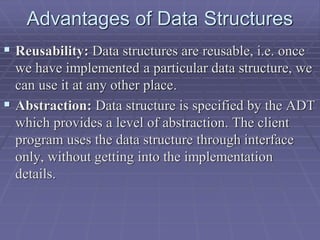
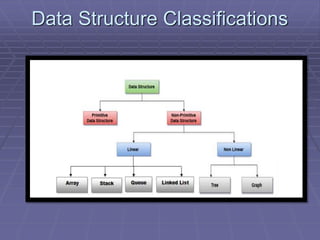
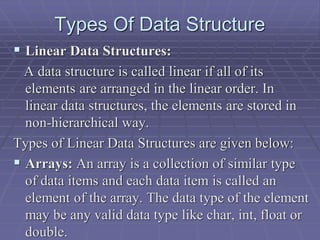
![Cont…
The elements of array share the same variable
name but each one carries a different index
number known as subscript. The array can be
one dimensional, two dimensional or
multidimensional.
The individual elements of the array age are:
age[0], age[1], age[2], age[3],......... age[98],
age[99].](https://image.slidesharecdn.com/chapter1introductiontodatastructuresandalgorithms-240415154424-4cb05444/85/Chapter-1-Introduction-to-Data-Structures-and-Algorithms-pdf-21-320.jpg)
